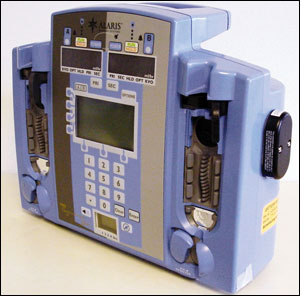Feb 22, 2010Since installing a hybrid infrared (IR) and RFID system to track assets at its facility in Terre Haute, Ind., Union Hospital has reduced the man-hours it spends searching for items, eliminated the staff's tendency to hoard those items, and reduced the amount of rental equipment it requires. According to Douglas Smith, Union Hospital's director of materials management, since the Versus Technology Asset Management Solution was installed in two phases—in November 2009 and January 2010—the facility has saved labor hours equivalent to one full-time employee. Recently, he says, a recall of vital-sign monitors (used to measure a patient's blood pressure, pulse rate, temperature and blood-oxygen level) put the system to the test, and allowed employees to locate specific items that had been recalled in a matter of minutes, thereby enabling the manufacturer to immediately replace the recalled components on the monitors.
Union Hospital recently completed an expansion to its existing 370,000-square-foot West Campus, with the addition of a 580,000-square-foot east wing. Last year, with the expansion still underway, Smith sought a solution for locating missing equipment, which already created an efficiency problem in the existing west campus by causing workers to spend many hours each week searching for epidural and IV pumps, as well as other missing items. Such challenges were likely to become even greater with a square-footage increase of more than 100 percent.
"We had hoarding going on," Smith explains, "and it was a constant battle to find the equipment that was needed." Because items such as epidural or IV pumps could be difficult to track down, the staff tended to horde those objects where they could always access them, exacerbating the problem of missing equipment. In addition, items such as wheelchairs and crutches were sometimes unavailable for patients when needed, and employees would have to walk the hospital floors searching for them. Staff members would have to make hourly checks of the soiled utility rooms, to determine if there was equipment there that required cleaning.
To address these issues, Union Hospital chose Versus' real-time location system (RTLS), which uses infrared technology for location tracking, as well as RFID as a back-up solution in the event that the IR signal is blocked or not operating properly. Versus' Advantages software for asset-tracking stores data related to the IR and RFID reads, and displays location information in the form of icons representing assets on a map of the facility. Smith says he liked the Versus solution because it came with modules that could later be added if the hospital so chose, such as a hand-washing tracking system, or a module for tracking refrigerator temperatures.
Versus has installed a total of 2,158 IR and RFID receivers to read transmissions from the tags, according to Tracy Shooltz, the company's customer service project coordinator. Battery-powered Versus VER 1832 tags, attached to assets via an adhesive, emit an IR beacon every three seconds that carries the tag's unique ID number. When the IR beacon is received by the IR reader within that location, the interrogator transmits its own ID number, along with that of the tag, to the Versus software system, which runs on the Union Hospital server but is not integrated with the facility's back-end system. "The Versus software is installed in application formats that can be launched and minimized to the toolbar, just as other programs on a Windows platform," Shooltz explains, though it need not be integrated with the hospital's management system.
In large rooms, such as the trauma center, Versus installed a higher number of IR readers in order to provide greater granularity, indicating the part of the room in which the item is located.
If the tag's IR signal is not being received (if, for example, a blanket is covering the tag and its infrared beacon), the RFID system provides a backup—the tag emits a 433 MHz RFID signal, also beaconing every three seconds, using a proprietary air-interface protocol. That signal is received by separate interrogators deployed throughout the facility, which send data to a concentrator that, in turn, forwards that information to the Versus software via a cabled connection. The software verifies that the tag is still in the facility, Shooltz says, though the RFID portion of the system does not indicate the location with as much granularity. Instead of, for instance, indicating the room or bed at which the tag is located, it would specify a zone, such as "Patient Floor 5, West."
The software allows staff members to run business reports, such as the length of time particular items spend at specific locations, though Smith says he is still learning how those business analytics can best be used by the hospital. The most striking demonstration of the system, he says, occurred when there was an equipment recall. The facility had purchased 50 vital-sign monitors, and subsequently learned from the manufacturer that 15 of them needed to have their circuit boards replaced. The manufacturer had the serial numbers of the items that had been recalled, and Smith was able to look them up on the system in a matter of minutes, and locate each item within the hospital. "We gave the report to the rep," Smith states, "and he went with a staff member on site and made all the changes."
"The staff likes the system because they aren't going out blindly looking for equipment," Smith adds. While employees previously might have spent 45 minutes to an hour walking hospital floors in search of equipment they may or may not have been able to locate, now they simply find the items using the software. The hospital has tagged nearly 2,000 items to date, and intends to continue tagging new pieces of equipment as the biomedical department identifies those that need to be tracked.


